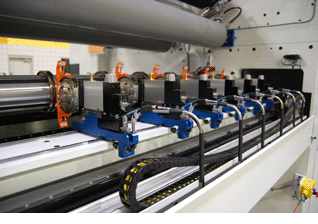by Joe Connelly , Product Manager – Winding and Slitting

In our last article we discussed the various types of automatic knife positioning systems available to the converting industry. But who benefits from using these systems in their slitter rewinders?
Just-in-time manufacturing and inventory reduction practices have required converters to change machine setups more frequently. Contract converters are also accustomed to frequent machine changeovers and compressed delivery schedules to satisfy customer requirements. Time spent setting up a converting machine for the next job equates to lost production capacity and reduced operator productivity, which in turn has a negative impact on the productivity and profitability of the entire converting operation. Any steps are taken to reduce machine setup time and to free-up machine operators for other duties can have a significant impact on improving overall operating efficiency.
For converters that process a variety of slit widths and rewind diameters off the same mill roll, avoiding long stoppage time between sets to set up the slitting components can impact productivity greatly. Arranging the slitting pattern automatically with the push of a button allows the operator time to prepare the next set of cores and start the next set more quickly. An automatic knife positioning system can reduce setup time greatly, particularly when only one operator is tending to the machine. While the operator is unloading the machine, setting up the rewind shafts, and loading new cores, the positioning system is busy moving knives to their next location in preparation for the next run. For other operations that require not only multiple width changes but also multiple material changes, having an automatic system working in the background while the operator is busy tending to the unwind and rewind sections eliminates this added setup time. Knife locations can typically be stored as recipes in the control system for recall the next time this setup is required. Another convenient time saver.
Finally, positioning accuracy for an automatic system will provide more consistency from run to run and minimize the chance for operator error in positioning knives. This will result in fewer mistakes, less wasted material, and improved customer satisfaction (fewer returns/claims), all of which will have a positive impact on profitability.